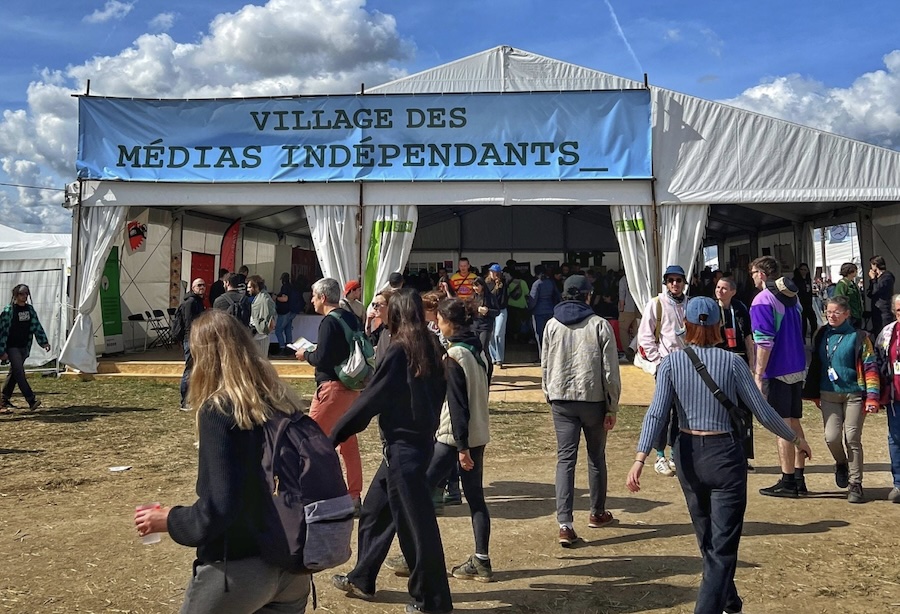FREE FLOW OF INFORMATION . .
An article by Juliette Quef in Vert.eco (translation by CPNN)
It’s urgent: in the face of the extreme right and the “bollorisation” of information, the ecosystem of “Indés” is joining forces by means of the Village of Independent Media at the Fête de l’Huma, the launch of a cooperative to finance them and a House of Free Media.
“It’s great that you’re here”, “it’s nice to see the independent media gathered together”: this weekend, La déferlante, Basta, Blast, Politis, Streetpress, Fakir, Reporterre, l’Age de Faire, Au poste, Mediapart, Socialter, Le média, Le chiffon, Reporters sans frontières, Acrimed, and of course Vert, were gathered under a huge 400 m² marquee, in the heart of the Fête de l’Huma, in Plessis-Pâté (Essonne). The 89th edition of the Fête attracted more than 450,000 participants in three days.
In the Village, at the center of the twenty or so stands, the conference space was filled with people and hosted rich discussions on sexist and sexual violence, freedom of the press and environmental mobilizations against the far right.

From September 13 to 15 at the Fête de l’Huma, the Village of Independent Media brought together around twenty media outlets. © Margot Desmons / Vert
Fight against the far right and the “bollorization” of the world
This first edition of the Independent Media Village at the Fête de l’Huma has its roots in the rallies against the far right, which were held on June 27 and July 3, Place de la République, in Paris. Organized in just a few days by the “Indés” and civil society, each of them brought together some 30,000 participants (our report).
“At that point, the priority was no longer our media but the event itself,” says Mathieu Molard, editor-in-chief of Streetpress, one of the initiators of the rallies. The unity of the organizers was very strong and we had the impression of having contributed, through these rallies and our investigations, to preventing the far right from gaining power.” With these links strengthened in the face of the emergency, the newspaper L’Humanité then offered to host the “Indés” at the Fête de l’Huma.
“The Independent Media Village was a huge success, we were always full,” rejoices Agnès Rousseaux, director of Politis. For me, it is a sign of a strong demand from the public for places where the press converges and an awareness on the part of the media that there is a need to strengthen and support each other. The Village gave us visibility that we would never have had on our own. Uniting allows us to increase our impact and our audience tenfold.”
(continued on right column)
(Click here for the French original of this article.)
Free flow of information, How is it important for a culture of peace?
(continued from left column)
Coop-media: financing the “Indés”, the nerve of the war
Faced with the rise of the extreme right, the actors of the social and solidarity economy (ESS) have also mobilized to accelerate their Coop-media project, a cooperative intended to finance independent media. Its launch is scheduled for October 9, at the Climate Academy, in Paris.
“Between ESS and independent media, we have the same challenges,” says Lucie Anizon, general secretary of Enercoop and one of the coordinators of Coop-media. We are facing behemoths and the alternatives are struggling.” The idea is to raise funds to participate in the financing of committed media that carry “humanist and progressive values for a more ecological, united and democratic society.”
Starting October 9, citizens, media and businesses will be able to take shares in Coop-media and participate in the governance of the cooperative according to the principle of 1 person = 1 vote. The fundraising will then make it possible to open calls for projects from 2025.
“I discovered a very disunited ecosystem of independent media,” confides Lucie Anizon. In the cooperative community, we know how to organize ourselves and we know that solidarity is the key to resilience.”
The initiative that has been rather well received by information professionals. “We lack structures that come to finance our media,” notes Mathieu Molard. “Banks do not understand our economic models. For example, they think that donations are not reliable. We have difficulty finding money, even public money, to develop ourselves, and this forces us to turn to private patrons.”
A House of Free Media to Welcome Everyone
After ten years of effort and an aborted project, the Paris Council has now voted unanimously to sell a building located at 70 boulevard Barbès, in the 18th arrondissement of Paris, to the left-wing millionaire Olivier Legrain, patron of the independent press and several refugee aid associations, and to the Bellevilles real estate company, to create a House of Free Media.
With a surface area of 4,000 m², it should accommodate, from the end of 2026, the premises of dozens of independent media and their ecosystem, video studios, as well as a café-bookstore and coworking spaces. The goal: to contribute to the defense of freedom of the press and pluralism in the media. “We want to create an emblematic place for freedom of the press in Paris,” explains Agnès Rousseaux. A space of excitement and abundance to wage the cultural battle and experiment with new ways of producing and disseminating information.”
– – –
If you wish to make a comment on this article, you may write to coordinator@cpnn-world.org with the title “Comment on (name of article)” and we will put your comment on line. Because of the flood of spam, we have discontinued the direct application of comments.